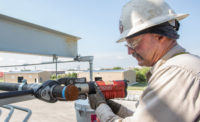But now there are ducts that are actually meant to be seen by occupants; indeed, they must be installed in the conditioned space to work as intended. Made out of fabric, these ducts are available in a wide array of colors to fit just about any design scheme.
In addition, fabric ducts are easy to install, and if they get dirty, they can be thrown into the washing machine. Seriously.
European Origins
Fabric duct first came about in Europe close to 30 years ago, when the food processing industry began to address problems with airflow being too hot or too cold. If an area became too hot, the food might become spoiled; if an area were too cold, workers might be too uncomfortable to do their jobs properly.Enter fabric duct. Basically, it works along the same concept as a soaker hose in your garden, except instead of water, air leaks out the full length of the ductwork. The duct is inflated with air, and that air leaks gently through the fabric, coming down onto the people below. The result is a draft-free atmosphere, which can be beneficial in many applications.
“Our ducts are made out of polyester material and are flame retardant, anti-mold and anti-bacteria, non-stretch, and water repellent,” says Niels Thorsen, president of FabricAir, Louisville, KY.
The company has been in the United States for about three years, but has been selling its fabric air-dispersion systems throughout Europe more than 30 years.
Custom Made
Thorsen notes that they have no standard off-the-shelf products; every duct system is custom made for each application.The company has several types of fabric duct. The type used depends on the application.
In comfort applications, low-surface velocity and draft-free air distribution are required. For applications that use mainly cooling, a fabric-only duct would be used that diffuses the air into the space. If cooling and heating are required, a duct system made of a fabric would be used; it would also feature integral air diffusion slots (manufactured from netting) running longitudinal along the diffuser.
Industrial applications require long throws and higher terminal velocities, so this type of ductwork is normally manufactured from impervious fire retardant fabric. Air distribution is achieved via an engineered pattern of holes drilled in the fabric and positioned so as to ensure compliance with a desired length of air throw and terminal velocity.
Industrial applications, in particular, can save money in energy costs with fabric duct. That’s because in many warehouse-like buildings, the ceiling may be 40 ft above the floor. Most of the time, sheet metal duct is installed up under the roof, which can capture all the heat load. Fabric duct can be hung much lower, and therefore is not subjected to higher heat loads and additional cooling.
Easy To Install, Maintain
Mold and mildew can grow in the nooks and crannies of typical ducts. However, the fibers in the fabric duct are resistant to mold and bacteria, and if they get dirty, the ducts can be taken down and washed, according to the company.“The ducts can be washed in a normal washing machine,” notes Thorsen. “We have an antishrink component, so when it’s washed in a normal washing machine and the fabric is dried and hung up, there’s no shrinkage whatsoever; it comes back to exactly where it was before. And there’s no other maintenance required.”
But what about putting the ducts back up in the right order? Not a problem, says Thorsen, because each 30-ft section of ductwork is numbered and the sections zip together. Zippering duct sections together takes a little more than a minute each, and as long as you can remember how to count, the ducts should go back up pretty easily.
In fact, they go up easily to begin with. You start with a tensioned cable that is strung across where the ductwork will be installed. Little plastic hook-type clips are sewn either on top of the duct or on either side (at 3:00 or 9:00) of the duct. These clips are then clipped over the cable. The fabric duct slides over the hard duct to whatever kind of equipment is heating or cooling the space and is then tied down. That’s it.
Because the installation is so simple, Thorsen states that a typical job can be finished in one-tenth of the time of a sheet metal application. “Contractors can save a lot of money, because there are savings up to about 50% in comparison to sheet metal when you do it with fabric ducting. Totally installed, they can install this for 50% less than they could with sheet metal. And most of that saving is in the labor.”
In addition, FabricAir will size the job and provide all the CAD drawings showing the complete layout. For complicated systems, the company tags each individual section of the duct with a special number that is taken from the drawing.
“When contractors get the drawing and when the UPS box arrives on-site” — the ducts are manufactured in Denmark — “all they need to do is look at the drawing and say, ‘I need section one,’ and it makes it easy for them to install because everything is numbered,” says Thorsen. “They just need to follow it.”
Fabric duct systems typically last about 18 to 20 years before they need to be replaced. The benefit to this, says Thorsen, is that the ductwork color can be updated to reflect any renovations that have taken place in the conditioned space.
Publication date: 10/29/2001





